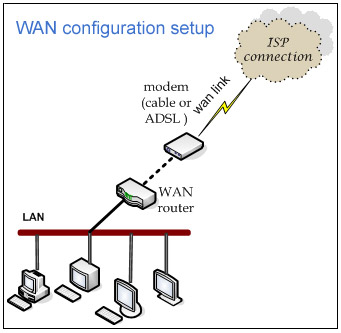Dual WAN and Load Balancing
A glimpse on WAN:
Every business organization has to withstand the competition in market for survival and business continuity amidst several issues. Today communication and information exchange has grew to a large extent such that even small scale organizations use technology to expand their network and carry on business transactions from remote places.
Technology has prospered to great heights that today it serves as a fuel for business vehicle. On the global edge, almost all companies whose branch office function world wide (like MNCs) need Internet access to stay connected and control the network from any remote location. Unhindered connectivity and quick access has become a feature that everyone desire. This is possible by a communication network infrastructure called ‘WAN or Wide Area Network’.
How can we configure WAN?
In general, business organizations configure WAN setup using single Internet connection provided by Internet Service Provider (ISP) connected to their LAN via wan modem. Modem is a device to perform modulation and demodulation of the signals traveling from source to destination. They link the local network to internet via wan port.
Here data transfer takes place when the packet data traverse from source, router routes packet to different nodes in the network using the address label in the routing table to reach the destination. Refer (To see Figure WAN configuration setup) for WAN setup for an organization.

Need for two or multiple connections:
Unhindered connectivity and fast access to Internet is the need of the hour for any organization that runs its business using Internet. Single ISP connection is quite risky as it leads to unbearable losses in case the network fails due to sudden disasters.
Here comes a new technology ‘Dual WAN’ that serves the purpose of maintaining network status always ‘up’ with two ISP connections (one as a backup), to function singular or together based on the mode of operation of the wan router and requirement of the organization.
Modes of Operation:
The dual modes of operation exist in dual wan routers serving dual purpose are:
1. Load Balancing: As per (below figure), we can make out the WAN setup with the dual wan router functioning as a load balancer.

In this mode, both the wan connections stay ‘active’ and load sharing between them based on the bandwidth. The dual wan load balancing avails two broadband connections aggregating the bandwidth overall. We can observe wan load balancing by the dual wan connections with one modem possessing high speed (cable modem) and other can be Digital Subscriber Line (DSL).
The internet traffic load balancing handled with both the links (wan link 1 and wan link 2) showing ‘active’ state. Given below is a representation of load balancing mode:

2. Automatic Failover or backup: In this mode only one wan link stays ‘active’ and is considered ‘primary’. When the primary wan connection fails, the alternate connection automatically takes over the control of the network and proceeds with the operations.

Hence, the name ‘automatic failover’ that avoids network disruption and collapse and maintain redundancy even at sudden disasters. Refer (below figure) for dual wan router working in automatic failover mode. So when one of the links fail, the status of the respective interface is ‘down’ and immediately alternate link becomes ‘active’ and traffic is passed through it.
Given below is a representation of automatic failover mode:

Market Scenario:
As per the organization requirements, current market has very few companies like Linksys, Dlink, and FatPipe Networks providing specialized WAN services coupled with internet load balancing. The characteristic features of WAN are nearly satisfied on a large scale in the products of FatPipe Networks. The technical team has worked on the network management issues and launched several products like QoS (for link load balancing), XTREME, and SUPERSTREAM in the market of which XTREME and SUPERSTREAM are refrained as hardware load balancers termed for their functionality.
FatPipe XTREME: As internet load balancers
XTREME is a network load-balancing device that perfectly suits any organization that has implemented WAN setup, ensuring redundancy and dynamic load balancing for outbound Internet traffic. XTREME opens multiple connections over multiple ISPs eliminating the need of BGP programming. Refer (To see Figure Working of FatPipe XTREME) for the setup of FatPipe ‘XTREME’.

FatPipe SUPERSTREAM:
This network load balancer has similar features as of the previous product but meets the needs of small-scale companies making maximum of ‘Four connections’ effectively working with any combination of transmission media (T1, T3, and DSL, wireless, ISDN and cable routers). Refer (To see Figure Working of FatPipe SUPERSTREAM) for working of FatPipe SUPERSTREAM.

In general, network professionals recommend users to opt for two connections with different service providers, as it is a safe option rather than using two wan connections of the same provider with varying IP addresses, are risky since the network can lose its connectivity in case primary wan connection fails to function. So if you are looking for best option for Dual WAN setup in your network with maximum benefits and efficiency, go ahead for the best one!


